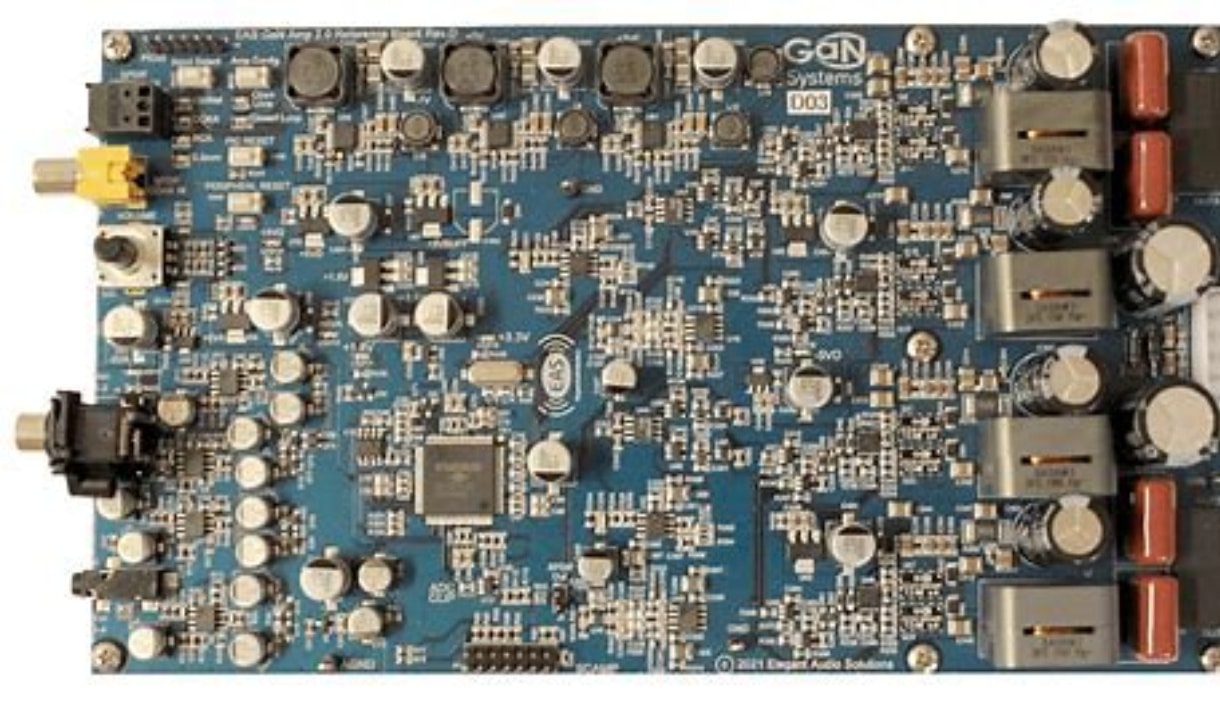The reference design balances high efficiency, outstanding audio output quality, and versatility in design customization, making it ideal for audio engineering and product development projects.

Class D amplifiers are a cornerstone of modern audio technology, celebrated for their high efficiency and excellent power-handling capabilities. Unlike their analogue counterparts, Class D amplifiers convert incoming analog signals into a series of high-frequency pulses, significantly reducing power loss and heat generation. This efficiency makes them ideal for a wide range of applications, from consumer electronics like portable speakers and home theater systems, to professional audio equipment and public address systems. Their compact design and ability to deliver powerful, high-fidelity audio while conserving energy and minimizing space requirements have made them an indispensable technology in the audio industry.
The GaN Class D Audio Amplifier reference design by Infineon, model GS-EVB-AUD-AMP2-GS, is an advanced platform for developing high-performance audio amplifiers. This evaluation board demonstrates the capabilities of a stereo Class-D audio amplifier, optimized for delivering robust sound quality with minimal power loss. Here’s a comprehensive overview of its features, benefits, and technical specifications:
The evaluation board is designed to provide a powerful audio output, featuring specifications such as 200 watts per channel into an 8-ohm load, 300 watts per channel into a 4-ohm load, and a continuous output power capacity of up to 400 watts. These capabilities ensure robust performance suitable for a variety of audio applications. This level of power output is maintained with exceptional efficiency, surpassing 96% under full load, thanks to the integration of GaN E-HEMTs (Gallium Nitride High Electron Mobility Transistors). The amplifier’s total harmonic distortion plus noise (THD+N) is impressively low at less than 0.03%, ensuring clear and crisp audio reproduction.
The design of the GS-EVB-AUD-AMP2-GS allows for scalability in power output through enhanced heatsinking and thermal management techniques. This feature makes it suitable for a range of audio applications, from home theater systems to professional audio setups. Accompanying the amplifier is the GS-EVB-AUD-SMPS2-GS, an evaluation board for a complete LLC Power Supply with Power Factor Correction (PFC). This power supply supports a universal AC line input voltage from 85V to 264V and provides a +/-32 VDC regulated output voltage. Like the amplifier, the power supply boasts high efficiency (greater than 90% at full load) and is capable of a 400W continuous output. Its design facilitates easy scaling by redesigning magnetic components alongside proper thermal management.
The amplifier utilizes Infineon’s proprietary CoolGaN power transistors, which contribute significantly to its high efficiency and performance. These transistors operate at 100V in the audio amplifier and 650V in the power supply unit. The evaluation board is engineered for fanless operation, requiring no external DC supplies due to its self-powered capability from the AC line input. Minimal external components are needed because of a high level of integration with the D2Audio Controller/Digital Signal Processor (DSP).
The high-performance class D stereo amplifier board supports both open-loop and closed-loop operations and accommodates various standard audio source inputs. This flexibility ensures that the evaluation board can be easily integrated into different audio systems and tailored to specific user requirements.
Infineon has tested this reference design. It comes with a bill of materials (BOM), schematics, a design file, etc. You can find additional data about the reference design on the company’s website. To read more about this reference design, click here.






